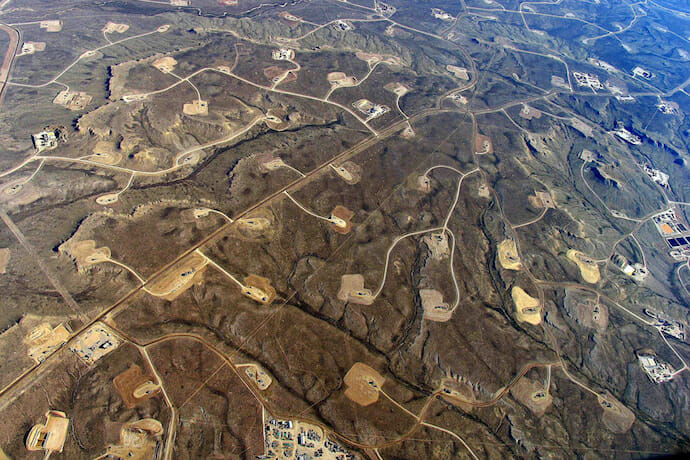
Hydraulic Fracking Deserves Another Look
The United States faces a challenge in order to meet its energy needs. As the world’s population continues to grow, so does the need for energy. But the geologically rich U.S. need not be dependent on other countries. Now that there are more advanced and greener production methods, hydraulic fracturing deserves another look.
Hydraulic fracturing, or fracking, is a process by which water, sand, and a chemical mixture are pumped at high pressure deep into a shale rock formation, forcing it to crack and release its natural gas pool. Once harvested, the natural gas is transported to refineries and then to power plants, producing much-needed electricity. Fracking has proven to be less damaging than once feared. It is cleaner than other non-renewable resources, and is an especially viable replacement for so called clean burning coal.
When refined, natural gas emits considerably less carbon dioxide than coal (1,135 lbs/megawatt-hour (MWh) compared to coal’s emission of 2,249 lbs/MWh) and produces less than a third as much nitrogen oxide and one percent as much sulfur oxide at the power plant. Moreover, at a recent question-and-answer session on climate change at Columbia University, U.S. Secretary of Energy Ernest J. Moniz extolled the positive impact of natural gas on the environment and its contribution toward meeting President Obama’s greenhouse gas reduction goal. Moniz told the audience, “The natural gas revolution has been a major contributor to reducing carbon emissions. The president has a goal of 17% [reduction] by 2020, we are about half way there, and half of that is because of the substitution of natural gas for coal in the power sector, essentially driven by market forces.”
This shift from coal to natural gas has resulted in the lowest level of carbon dioxide emissions in recent years, leading to better air quality for all. Although this decrease in carbon dioxide emissions is clear, water contamination is another issue. Each fracking well requires two to five million gallons of water pumped underground to fracture the rock, and the water flowing back out carries toxic chemicals used in the fracking process that can contaminate fresh water supplies.
New technology, however, is solving this issue as well. For example, GE recently developed a technique making it unnecessary to dilute the wastewater or transport it for treatment or disposal. Instead, at the harvesting site, it uses a “membrane distillation, which combines heat and decreased pressure to vaporize water using membranes to separate pure water vapor from salt water.” Also, nonfreshwater sources, such as brackish aquifers that cannot be used for drinking, agriculture or livestock, are increasingly being used in fracking. By reducing the potential for water contamination and by using greener and more advanced techniques, individual environments that depend on fresh water – habitats, ecosystems, and nature refuges –are protected as well.

Fracking also presents much needed opportunities for economic growth, especially in rural communities hit hard by the recession. In 2012 alone, fracking supported 2.1 million jobs nationwide and added $1,200 to overall household income. The Manhattan Institute for Policy Research recently performed a study comparing counties in Pennsylvania, which allow fracking, to counties in New York, which do not allow fracking. It found that Pennsylvania enjoyed significantly higher and faster economic growth between 2007 and 2011. In fact, per-capita income in Pennsylvania counties with more than 200 hydrofractured wells rose a staggering 19%, in counties with 20-200 wells and 14% in counties with fewer than 20 wells income rose 12%. In counties without any hydrofractured wells, income went up by only 8%. In addition, Pennsylvania counties with the lowest incomes experienced the most rapid economic growth.
In its analysis of nearly 5,000 wells in Pennsylvania, the Manhattan Institute also created data models for New York counties that shared similar geographic and economic indicators to determine potential economic growth. It then projected that the “income of residents in 28 New York counties above the Marcellus Shale [which includes western New York] has the potential to expand by 15 percent or more over the next four years – if the state’s moratorium is lifted.” They concluded that there was a direct connection between number of wells and higher economic growth and that “These results could equally well be applied to counties in New York and other states, from California to West Virginia, that have the potential to drill for oil and natural gas.”
These results match a similar study commissioned by the New York State Department of Environmental Conservation (NYSDEC) in 2009, which analyzed the potential job growth if the hydrofracturing ban was lifted in New York. It found that “hydraulic fracturing would directly create 25,000 jobs in well construction and operation, as well as 29,000 jobs in indirectly influenced industries, such as transportation. These 54,000 jobs would, in 2010, have represented approximately 0.7% of the labor force.” As demonstrated in these reports, fracking has the potential to lift communities out of their economic slumps, and provide states with much needed tax revenue.
Recent fracking measures have also helped the U.S. to achieve its highest energy output in over twenty years, thereby moving the U.S. closer to energy independence. In fact, the U.S. was able to meet 89% of its own energy needs during the first three months of 2013, while also increasing its exports. Bloomberg News reporter Asjylyn Loder explains, “Rising crude supplies from oilfields, including North Dakota’s Bakken shale and the Eagle Ford in Texas, have helped the U.S. become the world’s largest exporter of refined fuels, including gasoline and diesel. The shale boom has also helped cut world reliance on OPEC oil even as global demand gains.”
The U.S. has the resources it needs – natural gas pools and fracking techniques to harvest them – so there is no reason for the U.S. to be dependent on other countries for energy. Furthermore, because the U.S. is cutting its consumption of foreign fuel and emerging nations are expanding and developing their own resources, worldwide reliance on OPEC is declining. OPEC recently announced that “consumption of its crude will decline 300,000 barrels a day next year to 29.6 million, 2.6% less than the 12-member group is pumping now” even while “world oil consumption will advance by 1 million barrels a day, or 1.2%, to 90.7 million next year.” As the U.S. becomes more self-sufficient by tapping into its own natural resources, the power of OPEC will begin to dwindle.
The U.S.’s energy goal is sustainability – environmental and economical – and hydrofracturing meets that goal. It is the cleanest fossil fuel available, and it has the power to lift local economies. It is also a politically neutral solution, combining the left’s idealism of long-term sustainability with the right’s pragmatism of a short-term solution while moving the U.S. closer toward energy independence. Although it is a non-renewable resource and not in itself a long-term solution, it has the power to carry the U.S. into the next decades, giving science and technology a chance to catch up with renewable alternatives. It certainly deserves another look in order to meet America’s growing energy needs.

